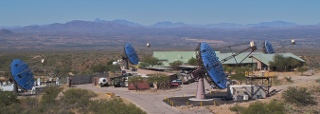The VERITAS Array: VERITAS (Very Energetic Radiation Imaging Telescope Array System) is a system of four ground-based telescopes focused on gamma-ray science. Since gamma rays cannot penetrate the atmosphere, the telescopes observe the Cherenkov light emitted by showers of particles produced when the gamma rays interact in the Earth’s atmosphere. They can then image the trajectories of the secondary particles passing through the atmosphere, and use this information to infer the arrival direction and energy of the original gamma ray.
Credit: M. Schroedter, SAO
Another question you often hear is whether we need to do the science we do from space, or if we can do it from the ground. There is a lot we can do with Earth-based instruments. You can actually observe gamma rays from the ground by indirect means, using Earth’s atmosphere as a detector. When high energy photons hit the atmosphere they create an avalanche of particles that you can detect on Earth. But in the MeV-scale regime you are simply bound to do it from space. At the very least you have to have a detector in space that can pinpoint the position of gamma-ray bursts accurately enough so you can point ground-based instruments at that location, and then track their optical-infrared-radio afterglow emission.
I could easily see the next generation getting excited about putting a group of women on Mars. And a bunch of men on Venus, maybe. But as with all research we have to ask, Is that actually feasible on the right time scale, and is it affordable? There are a lot of considerations when making decisions about pursuing and funding space research. And if the mechanism for doing space research were to go away, if we went to a private enterprise model of commercial space exploration, how would that affect research? Is Virgin Galactic going to let me build a satellite? Are they interested in letting me look at X-ray stars or are they just interested in putting a space tourism center in orbit?


